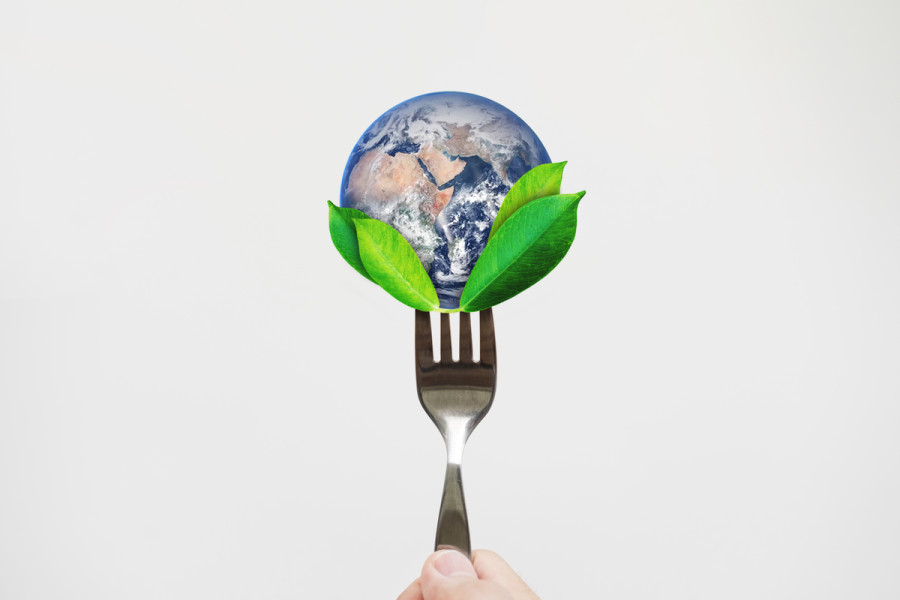Columns
Depleting nutrition in our food
Rising CO2 concentration causing nutrient depletion in crops raises serious concerns about future food security.
Madhukar Upadhya
The frequency and intensity of weather-related hazards have progressively increased, posing threats to our food security. But the growing climate concerns do not seem to stop at floods, droughts, delayed or early monsoon rains and above or below-average annual rains. There is another layer on top of the already competing interests of policy responses to address climate impacts—nutrient deficiency in food caused by increased carbon dioxide (CO2) concentration in the atmosphere. More and more studies now suggest that a higher concentration of CO2, which helps plants grow bigger and faster, often producing too many carbohydrates, also directly impacts the overall nutritional content, especially that of protein, iron, zinc, calcium and other essential food nutrients.
Health connections
With no substantial progress in cutting global emissions despite repeated pledges made during international climate summit meetings, the problem of nutrient deficiency will only deteriorate in the future. This will hurt low-income countries like Nepal, which are already facing the consequences of micronutrient deficiency. According to the 2016 Nepal National Micronutrient Status Survey, about 21 percent of children below five and about 24 percent of non-pregnant women aged between 15 and 49 are already zinc deficient. About 20 percent of non-pregnant women also suffer from iron deficiency.
Predictably, these nutrient deficiencies cause health problems. For instance, zinc and iron deficiencies have been known to cause chronic health issues, usually associated with stunted growth in children, impaired physical and cognitive development, depressed immune function, increased vulnerability to and severity of infection, anaemia, adverse outcomes of pregnancy and neurobehavioral abnormalities. Zinc is also important for skin health. Additionally, rice and wheat, staples of a significant section of the population, are affected more by higher CO2 concentration. Controlled experiments have shown vegetables being similarly affected; calcium in green beans dropped significantly, vitamin A levels in asparagus plummeted by almost half, and broccoli stalks were found to have less iron.
So far, nutrient deficiency has been regarded as a result of improper diet, poverty and poor access to food. However, this will change as the food itself will have less nutritional value due to climate impacts on the nutrient content of cereals, pulses and vegetables. Even when one has access to a proper diet and adequate amounts of food, it may still result in nutrient deficiency because of lesser nutrients in the food. A paper titled “Micronutrients deficiency, a hidden hunger in Nepal: Prevalence, causes, consequences and solutions”, published in 2015, indicates that the underlying cause of zinc deficiency is the low content of vitamins and minerals in food.
The far-reaching implications of nutrient deficiencies are that as floods, droughts and heatwaves lower agricultural productivity and as higher atmospheric CO2 levels reduce the concentration of essential micronutrients in food, existing micronutrient deficiencies worsen, leading to greater numbers of malnourished people. The economic loss in Nepal, according to an estimate, is already about 2 to 3 percent of GDP on account of existing vitamin and mineral deficiencies alone.
Remedial options
There are various ways to respond to these emerging food nutrition issues. Some of them are quick while others take time to yield results. One of the most sought-after solutions is adding micronutrients directly into the seeds. This, however, is only a quick fix and does not provide lasting change because the technique focuses on one or two micronutrients at a time, whereas the state of other micronutrients will continue to be affected by higher CO2. In addition, it will take away the freedom of farmers to produce seeds, instead making them dependent on imported seeds, which may be out of reach for small farmers. It also raises the question of what will happen to varieties of crops adapted to the local environment.
Another way is to apply nutrient-rich fertilisers or soil amendments to infuse the plants with particular minerals. An effective and low-cost way of enhancing growth by treating the seeds and using bio-fertilisers already exists in Nepal. However, adding nutrient-rich fertiliser without addressing soil erosion is unlikely to help. Numerous studies in Nepal since the 1970s have highlighted soil erosion as a major impediment to enhancing agricultural production, but no effective measures have been taken to address it. Erosion tends to deplete the soil of both major and micronutrients. Consequently, we have started to see the results of not responding to the call for conserving soil.
Farming is being abandoned due to the continued loss of farm productivity, largely caused by erosion of soil nutrients. Institutionally, the responsibility of formulating soil conservation policies and advocating for their implementation lies with the forestry sector, which currently bears no responsibility for managing agriculture soil. If we address the unchecked soil erosion of farmlands before applying nutrient-rich fertilisers, we may help address nutrient content in food in both the short and long term. For this, we must facilitate better soil management, including soil conservation, on a massive scale.
A third approach could be selective plant breeding, which has also been suggested as an effective way to develop seeds less affected by higher levels of CO2. Nepal’s institutional set-up and pool of expertise in plant breeding are well-placed for that purpose. They have developed flood- and drought-resistant rice, maize and millet varieties to protect crops against submergence and droughts. A combination of soil conservation backed by plant breeding would be a better answer to the impacts of higher CO2 concentration.
Expanding adaptation scope
In sum, our food security is being threatened by an avalanche of issues, from water scarcity, floods, wind storms, landslides and plant diseases, to impacts on the nutritional content of food. Food security will no longer be merely a question of access to food, as is generally understood; it will be a question of food availability with the required amount of nutrients. The national policies and strategies on nutrition highlight the issue of existing nutrient deficiencies and their health impacts, which increase with rising CO2 concentration.
Many people are already nutrient-deficient, and the likelihood of depleting nutrients in the future due to rising CO2 concentration raises serious concerns regarding our food security. This is an emerging issue that hasn’t been part of our climate response yet. Given that we are confronted with multiple climate-related agricultural issues, it’s time to start identifying and weaving implementable measures to address the nutritional content of food into our adaptation plans.




 29.12°C Kathmandu
29.12°C Kathmandu















